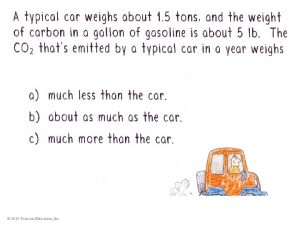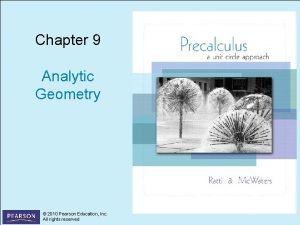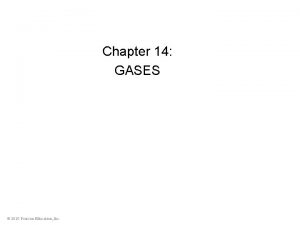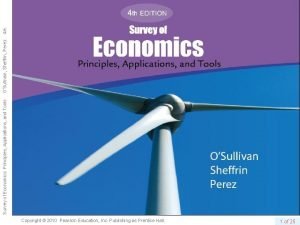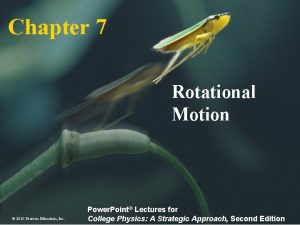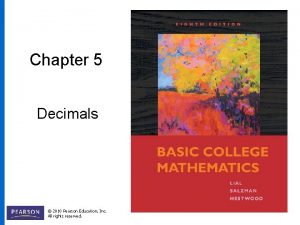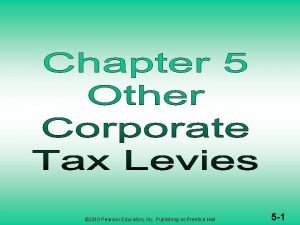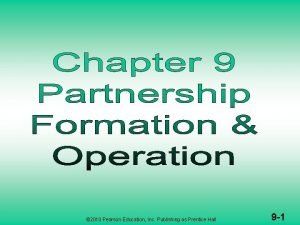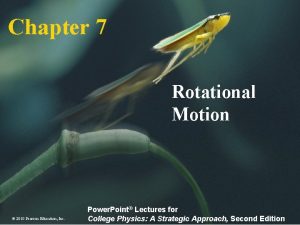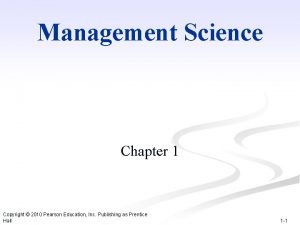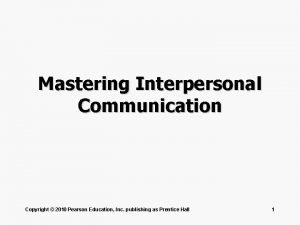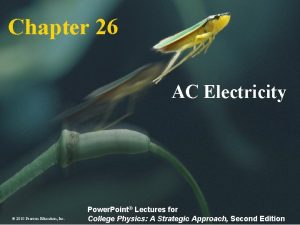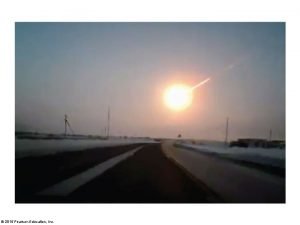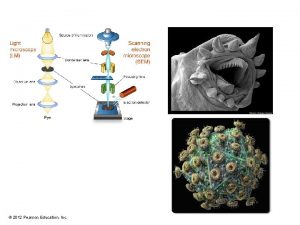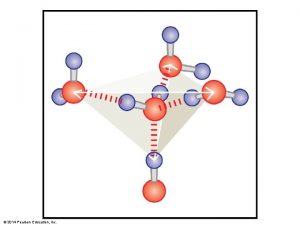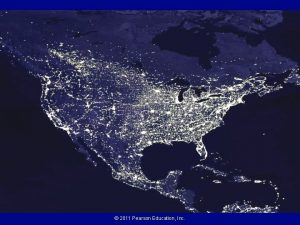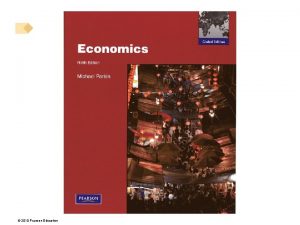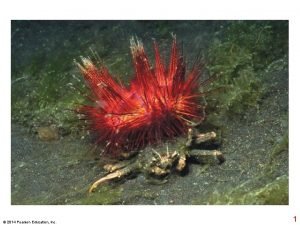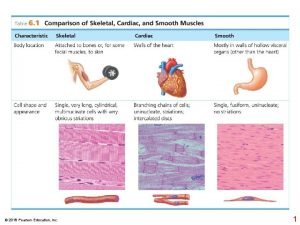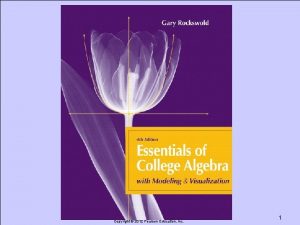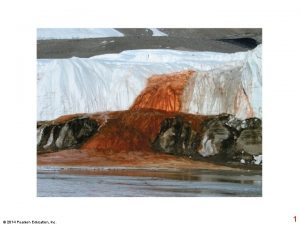2010 Pearson Education Inc Energy Property of a













































- Slides: 45

© 2010 Pearson Education, Inc.

Energy • Property of a system that enables it to do work • Anything that can be turned into heat Example: Electromagnetic waves from the Sun Matter • Substance we can see, smell, and feel • Occupies space © 2010 Pearson Education, Inc.

Work • involves force and distance. • is force distance. • in equation form: W Fd. Two things occur whenever work is done: • application of force • movement of something by that force © 2010 Pearson Education, Inc.

Work CHECK YOUR NEIGHBOR If you push against a stationary brick wall for several minutes, you do no work A. B. C. D. on the wall. at all. Both of the above. None of the above. © 2010 Pearson Education, Inc.

Work CHECK YOUR ANSWER If you push against a stationary brick wall for several minutes, you do no work on the wall. B. at all. C. Both of the above. D. None of the above. A. Explanation: You may do work on your muscles, but not on the wall. © 2010 Pearson Education, Inc.

Work Examples: • Twice as much work is done in lifting 2 loads 1 story high versus lifting 1 load the same vertical distance. Reason: force needed to lift twice the load is twice as much. • Twice as much work is done in lifting a load 2 stories instead of 1 story. Reason: distance is twice as great. © 2010 Pearson Education, Inc.

Work Example: • a weightlifter raising a barbell from the floor does work on the barbell. Unit of work: newton-meter (Nm) or joule (J) © 2010 Pearson Education, Inc.

Work CHECK YOUR NEIGHBOR Work is done in lifting a barbell. How much work is done in lifting a barbell that is twice as heavy the same distance? A. B. C. D. Twice as much Half as much The same Depends on the speed of the lift © 2010 Pearson Education, Inc.

Work CHECK YOUR ANSWER Work is done in lifting a barbell. How much work is done in lifting a barbell that is twice as heavy the same distance? Twice as much B. Half as much C. The same D. Depends on the speed of the lift A. Explanation: This is in accord with work force distance. Twice the force for the same distance means twice the work done on the barbell. © 2010 Pearson Education, Inc.

Work CHECK YOUR NEIGHBOR You do work when pushing a cart with a constant force. If you push the cart twice as far, then the work you do is A. B. C. D. less than twice as much. more than twice as much. zero. © 2010 Pearson Education, Inc.

Work CHECK YOUR ANSWER You do work when pushing a cart with a constant force. If you push the cart twice as far, then the work you do is A. B. C. D. less than twice as much. more than twice as much. zero. © 2010 Pearson Education, Inc.

Power: • Measure of how fast work is done • In equation form: © 2010 Pearson Education, Inc.

Power Example: • A worker uses more power running up the stairs than climbing the same stairs slowly. • Twice the power of an engine can do twice the work of one engine in the same amount of time, or twice the work of one engine in half the time or at a rate at which energy is changed from one form to another. © 2010 Pearson Education, Inc.

Power Unit of power • joule per second, called the watt after James Watt, developer of the steam engine • 1 joule/second 1 watt • 1 kilowatt 1000 watts © 2010 Pearson Education, Inc.

Power CHECK YOUR NEIGHBOR A job can be done slowly or quickly. Both may require the same amount of work, but different amounts of A. B. C. D. energy. momentum. power. impulse. © 2010 Pearson Education, Inc.

Power CHECK YOUR ANSWER A job can be done slowly or quickly. Both may require the same amount of work, but different amounts of A. B. C. D. energy. momentum. power. impulse. Comment: Power is the rate at which work is done. © 2010 Pearson Education, Inc.

Mechanical Energy Mechanical energy is due to position or to motion, or both. There are two forms of mechanical energy: • Potential energy • Kinetic energy © 2010 Pearson Education, Inc.

Potential Energy Stored energy held in readiness with a potential for doing work Example: • A stretched bow has stored energy that can do work on an arrow. • A stretched rubber band of a slingshot has stored energy and is capable of doing work. © 2010 Pearson Education, Inc.

Potential Energy—Gravitational Potential energy due to elevated position Example: • water in an elevated reservoir • raised ram of a pile driver © 2010 Pearson Education, Inc.

Potential Energy—Gravitational • Equal to the work done (force required to move it upward the vertical distance moved against gravity) in lifting it • In equation form: Potential energy mass acceleration due to gravity height mgh © 2010 Pearson Education, Inc.

Potential Energy CHECK YOUR NEIGHBOR Does a car hoisted for repairs in a service station have increased potential energy relative to the floor? A. B. C. D. Yes No Sometimes Not enough information © 2010 Pearson Education, Inc.

Potential Energy CHECK YOUR ANSWER Does a car hoisted for repairs in a service station have increased potential energy relative to the floor? A. B. C. D. Yes No Sometimes Not enough information Comment: If the car were twice as heavy, its increase in potential energy would be twice as great. © 2010 Pearson Education, Inc.

Potential Energy Example: Potential energy of 10 -N ball is the same in all 3 cases because work done in elevating it is the same. © 2010 Pearson Education, Inc.

Kinetic Energy • Energy of motion • Depends on the mass of the object and square of its speed • Include the proportional constant 1/2 and kinetic energy 1/2 mass speed • If object speed is doubled kinetic energy is quadrupled. © 2010 Pearson Education, Inc.

Kinetic Energy CHECK YOUR NEIGHBOR Must a car with momentum have kinetic energy? A. Yes, due to motion alone B. Yes, when motion is nonaccelerated C. Yes, because speed is a scalar and velocity is a vector quantity D. No © 2010 Pearson Education, Inc.

Kinetic Energy CHECK YOUR ANSWER Must a car with momentum have kinetic energy? A. Yes, due to motion alone B. Yes, when momentum is nonaccelerated C. Yes, because speed is a scalar and velocity is a vector quantity D. No Explanation: Acceleration, speed being a scalar, and velocity being a vector quantity are irrelevant. Any moving object has both momentum and kinetic energy. © 2010 Pearson Education, Inc.

Kinetic Energy Kinetic energy and work of a moving object • Equal to the work required to bring it from rest to that speed, or the work the object can do while being brought to rest • In equation form: net force distance kinetic energy, or Fd 1/2 mv 2 © 2010 Pearson Education, Inc.

Work-Energy Theorem Work-energy theorem • Gain or reduction of energy is the result of work. • In equation form: work change in kinetic energy (W KE). • Doubling speed of an object requires 4 times the work. © 2010 Pearson Education, Inc.

Work-Energy Theorem • Applies to decreasing speed: – reducing the speed of an object or bringing it to a halt Example: Applying brakes stopping to slow a moving car, work is done on it (the friction force supplied by the brakes distance © 2010 Pearson Education, Inc.

Work-Energy Theorem CHECK YOUR NEIGHBOR Consider a problem that asks for the distance of a fastmoving crate sliding across a factory floor and then coming to a stop. The most useful equation for solving this problem is A. F ma. B. Ft mv. C. KE 1/2 mv 2. D. Fd 1/2 mv 2. © 2010 Pearson Education, Inc.

Work-Energy Theorem CHECK YOUR ANSWER Consider a problem that asks for the distance of a fastmoving crate sliding across a factory floor and then coming to a stop. The most useful equation for solving this problem is A. F ma. B. Ft mv C. KE 1/2 mv 2. D. Fd 1/2 mv 2. Comment: The work-energy theorem is the physicist’s favorite starting point for solving many motion-related problems. © 2010 Pearson Education, Inc.

Work-Energy Theorem CHECK YOUR NEIGHBOR The work done in bringing a moving car to a stop is the force of tire friction stopping distance. If the initial speed of the car is doubled, the stopping distance is A. B. C. D. actually less. about the same. twice. None of the above. © 2010 Pearson Education, Inc.

Work-Energy Theorem CHECK YOUR ANSWER The work done in bringing a moving car to a stop is the force of tire friction stopping distance. If the initial speed of the car is doubled, the stopping distance is A. B. C. D. actually less. about the same. twice. None of the above. Explanation: Twice the speed means four times the kinetic energy and four times the stopping distance. © 2010 Pearson Education, Inc.

Conservation of Energy Law of conservation of energy • Energy cannot be created or destroyed; it may be transformed from one form into another, but the total amount of energy never changes. © 2010 Pearson Education, Inc.

Conservation of Energy Example: Energy transforms without net loss or net gain in the operation of a pile driver. © 2010 Pearson Education, Inc.

Conservation of Energy A situation to ponder… Consider the system of a bow and arrow. In drawing the bow, we do work on the system and give it potential energy. When the bowstring is released, most of the potential energy is transferred to the arrow as kinetic energy and some as heat to the bow. © 2010 Pearson Education, Inc.

A situation to ponder… CHECK YOUR NEIGHBOR Suppose the potential energy of a drawn bow is 50 joules and the kinetic energy of the shot arrow is 40 joules. Then A. B. C. D. energy is not conserved. 10 joules go to warming the bow. 10 joules go to warming the target. 10 joules are mysteriously missing. © 2010 Pearson Education, Inc.

A situation to ponder… CHECK YOUR ANSWER Suppose the potential energy of a drawn bow is 50 joules and the kinetic energy of the shot arrow is 40 joules. Then A. B. C. D. energy is not conserved. 10 joules go to warming the bow. 10 joules go to warming the target. 10 joules are mysteriously missing. Explanation: The total energy of the drawn bow, which includes the poised arrow, is 50 joules. The arrow gets 40 joules and the remaining 10 joules warms the bow—still in the initial system. © 2010 Pearson Education, Inc.

Kinetic Energy and Momentum Compared Similarities between momentum and kinetic energy: • Both are properties of moving things. Difference between momentum and kinetic energy: • Momentum is a vector quantity and therefore is directional and can be canceled. • Kinetic energy is a scalar quantity and can never be canceled. © 2010 Pearson Education, Inc.

Kinetic Energy and Momentum Compared • Velocity dependence – Momentum depends on velocity. – Kinetic energy depends on the square of velocity. Example: An object moving with twice the velocity of another with the same mass, has twice the momentum but 4 times the kinetic energy. © 2010 Pearson Education, Inc.

Sources of Energy Sources of energy Sun Example: • Sunlight evaporates water; water falls as rain; rain flows into rivers and into generator turbines; then back to the sea to repeat the cycle. • Sunlight can be transformed into electricity by photovoltaic cells. • Wind power turns generator turbines. © 2010 Pearson Education, Inc.

Sources of Energy Sources of energy Sun Example: • Photovoltaic cells on rooftops catch the solar energy and convert it to electricity. More energy from the Sun hits Earth in 1 hour than all of the energy consumed by humans in an entire year! © 2010 Pearson Education, Inc.

Sources of Energy Fuel cell • Runs opposite to the battery shown (where electricity separates water into hydrogen and oxygen). • In a fuel cell, hydrogen and oxygen are compressed at electrodes and electric current is produced at electrodes. © 2010 Pearson Education, Inc.

Sources of Energy Concentrated energy • Nuclear power – stored in uranium and plutonium – by-product is geothermal energy • held in underground reservoirs of hot water to provide steam that can drive turbogenerators © 2010 Pearson Education, Inc.

Sources of Energy • Dry-rock geothermal power is a producer of electricity. – Water is put into cavities in deep, dry, hot rock. Water turns to steam and reaches a turbine, at the surface. After exiting the turbine, it is returned to the cavity for reuse. © 2010 Pearson Education, Inc.
 2010 pearson education inc
2010 pearson education inc 2010 pearson education inc
2010 pearson education inc 2010 pearson education inc
2010 pearson education inc 2010 pearson education inc answers
2010 pearson education inc answers 2010 pearson education inc answers
2010 pearson education inc answers 2010 pearson education inc answers
2010 pearson education inc answers 2010 pearson education inc
2010 pearson education inc 2010 pearson education inc
2010 pearson education inc Copyright 2010 pearson education inc
Copyright 2010 pearson education inc 2010 pearson education inc
2010 pearson education inc Copyright 2010 pearson education inc
Copyright 2010 pearson education inc The four forces shown have the same strength
The four forces shown have the same strength Pearson education inc 5
Pearson education inc 5 2010 pearson education inc
2010 pearson education inc 2010 pearson education inc
2010 pearson education inc Pearson education inc. all rights reserved
Pearson education inc. all rights reserved Two coins rotate on a turntable
Two coins rotate on a turntable 2010 pearson education inc
2010 pearson education inc 2010 pearson education inc
2010 pearson education inc 2010 pearson education inc answers
2010 pearson education inc answers 2010 pearson education inc
2010 pearson education inc 2010 pearson education inc
2010 pearson education inc Copyright 2010 pearson education inc
Copyright 2010 pearson education inc Copyright 2010 pearson education inc
Copyright 2010 pearson education inc Copyright 2010 pearson education inc
Copyright 2010 pearson education inc 2010 pearson education inc
2010 pearson education inc Copyright 2010 pearson education inc
Copyright 2010 pearson education inc Copyright 2010 pearson education inc
Copyright 2010 pearson education inc Copyright 2010 pearson education inc
Copyright 2010 pearson education inc Pearson education inc. all rights reserved
Pearson education inc. all rights reserved 2010 pearson education inc answers
2010 pearson education inc answers Balance sheet pearson
Balance sheet pearson Reorder point formula example
Reorder point formula example Pearson education inc. publishing as prentice hall
Pearson education inc. publishing as prentice hall Prentice hall publishing
Prentice hall publishing Pearson education 2011
Pearson education 2011 Pearson education inc publishing as pearson prentice hall
Pearson education inc publishing as pearson prentice hall 2012 pearson education inc
2012 pearson education inc Copyright 2008
Copyright 2008 2018 pearson education inc
2018 pearson education inc 2017 pearson education ltd
2017 pearson education ltd Copyright by pearson education inc. answers
Copyright by pearson education inc. answers 2017 pearson education inc
2017 pearson education inc 2017 pearson education inc
2017 pearson education inc 2017 pearson education inc
2017 pearson education inc 2017 pearson education inc
2017 pearson education inc



